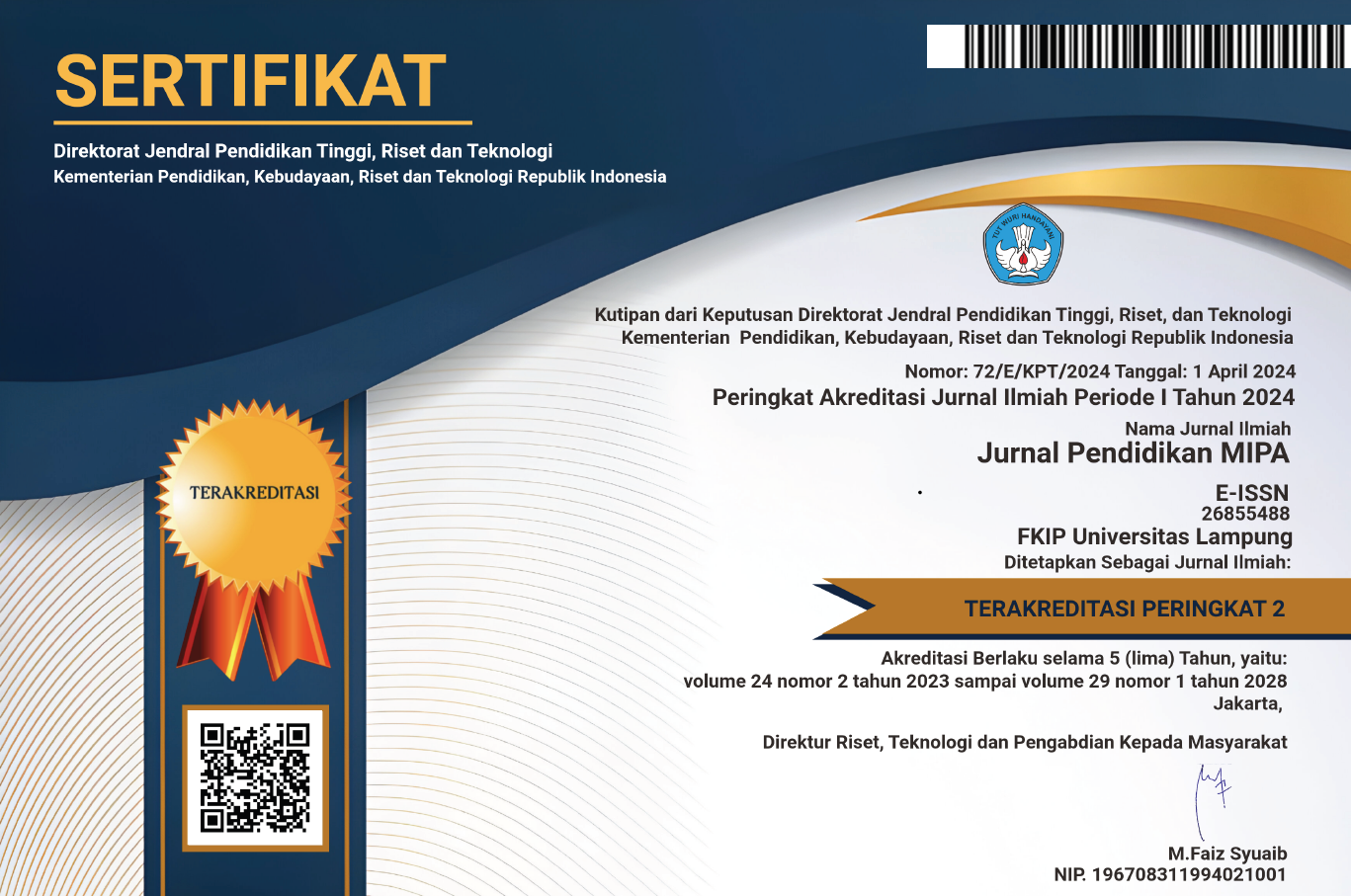Exploration of Fort Marlborough Bengkulu and Its Implications for Mathematics Learning in School
 Country:
Country:
(1) University of Bengkulu, Indonesia
(2) University of Bengkulu, Indonesia
(3) University of Bengkulu, Indonesia
| Metrics→ |
| Indexing Site→ |
Copyright (c) 2022 Zamzaili Zamzaili, Rizki Riyani, Saleh Haji
This study aims to describe the facts, concepts, principles, and mathematical operations contained in the ethnomathematics of Fort Marlborough Bengkulu. This research is qualitative research with an ethnographic approach. The subjects in this study were seven: one Bengkulu history expert, two Marlborough Fort synthesizers, two mathematicians, and two Bengkulu City mathematics teachers. Data were collected through observation, interviews, and documentation. The data were analyzed through three stages, data reduction, data presentation, and conclusion. The results of the research found include, there are mathematical facts on the ethnomathematics of the Marlborough fort Bengkulu, Facts in the form of points, wake-up webs, lines, and line segments. Concepts: flat build, space build, trigonometry on the building and courtyard of Fort Marlborough. Principles: area and perimeter of plane figures, quadratic functions, volumes and surface areas of figures, trigonometric ratios:
Keywords: ethnomathematics, ethnographic research, Fort Marlborough
Agustina, L. (2016). Upaya meningkatkan kemampuan pemahaman konsep dan pemecahan masalah matematika siswa SMP Negeri 4 Sipirok kelas VII melalui pendekatan matematika realistik (PMR). Jurnal Eksakta, 1.
Aulia, L. R., Dewi, D. A., & Furnamasari, Y. F. (2021). Mengenal indentitas nasional Indonesia sebagai jati diri bangsa untuk menghadapi tantangan di era globalisasi. Jurnal Pendidikan Tambusai, 5(3), 8549–8557.
Bishop, J. A. (1994). Cultural conflicts in the mathematics education of indigenous people. Clayton, Victoria: Monash University.
Hadi, S. (2014). Konsep apik dalam koreografi wayang babar. Jurnal Kawistara, 4(1).
Haji, S., & Octizasari. (2018). Penerapan model pembelajaran RME berbasis ethnomatematika untuk meningkatkan kemampuan pemecahan masalah mahasiswa calon guru pendidikan matematika FKIP Universitas Bengkulu. Jurnal Pendidikan Matematika, 1(1), 1–8.
Haji, S., & Yumiati. (2018). Nilai-nilai matematika pada batik Besurek Bengkulu. Jurnal Pendidikan Matematika Raflesia Bengkulu, 3(1), 1–9.
Haji, S., Yumiati, & Zamzaili. (2019). Improving students' productive disposition through realistic mathematics education with outdoor approach. Journal of Research and Advances in Mathematics Education, 4(2), 101–111.
Hiebert, J., & Carpenter, T. P. (1992). Learning and teaching with understanding. In Handbook of Research on Mathematics Teaching and Learning: A Project of the National Council of Teachers of Mathematics (pp. 65–97).
Irsyad, M., Sujadi, A. A., & Setiana, D. S. (2020). Eksplorasi etnomatematika pada Candi Asu. UNION: Jurnal Ilmiah Pendidikan Matematika, 8(1), 11.
Massarwe, K., Verner, I., & Bshouty, D. (2012). Ethnomathematics and multicultural education: Analysis and construction of geometric ornaments. Journal of Mathematics and Culture, 4, 344–360.
Palhares, P., & Shirley, L. (2015). The role of ethnomathematics in mathematics education. In The Proceedings of the 12th International Congress on Mathematical Education (pp. 575–578). https://doi.org/10.1007/978-3-319-12688-3_61
Prahmana, R. C. I., Yunianto, W., Rosa, M., & Orey, D. C. (2021). Ethnomathematics: "Pranatamangsa" system and the birth-death ceremonial in Yogyakarta. Journal on Mathematics Education, 12(1), 93–112.
Rowlands, S., & Carson, R. (2002). Where would formal, academic mathematics stand in a curriculum informed by ethnomathematics? A critical review of ethnomathematics. Educational Studies in Mathematics, 50(1), 79–102.
Sari, A. K., Budiarto, M. T., & Ekawati, R. (2022). Ethnomathematics study: Cultural values and geometric concepts in the traditional "Tanean-Lanjang" house in Madura–Indonesia. JRAMathEdu (Journal of Research and Advances in Mathematics Education), 7(1), 46–54.
Sarwoedi, S., Marinka, D. O., Febriani, P., & Wirne, I. N. (2018). Efektivitas etnomatematika dalam meningkatkan kemampuan pemahaman matematika siswa. Jurnal Pendidikan Matematika Raflesia, 3(2), 171–176.
Setiana, D. S. (2020). The role of ethnomathematics in welcoming the society 5.0. In SEMANTIK Conference of Mathematics Education (SEMANTIK 2019) (pp. 130–134).
Supiyati, S., & Hanum, F. (2019). Ethnomathematics in Sasaknese architecture. Journal on Mathematics Education, 10(1), 47–58.
Susanto, A. (2012). Nilai matematika dan pendidikan matematika dalam pembentukan kepribadian. Jurnal Universitas Veteran Bangun Nusantara Sukoharjo. http://journal.um.ac.id
Valentino, E. (2016). Analisis kesalahan buku siswa matematika kelas VIII SMP/MTs semester I kurikulum 2013. Jurnal STKIP Bina Insan Mandiri Surabaya.
Wahyuni, A., Tias, A., & Sani, B. (2013). Peran etnomatematika dalam membangun karakter bangsa. Jurnal Pendidikan Matematika FMIPA UNY.
Refbacks
- There are currently no refbacks.

This work is licensed under a Creative Commons Attribution-ShareAlike 4.0 International License.

The copyright is reserved to The Jurnal Pendidikan MIPA that is licensed under a Creative Commons Attribution-ShareAlike 4.0 International License.


